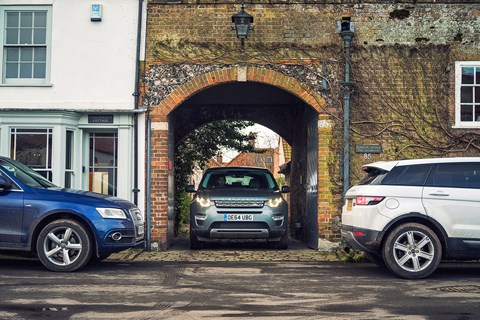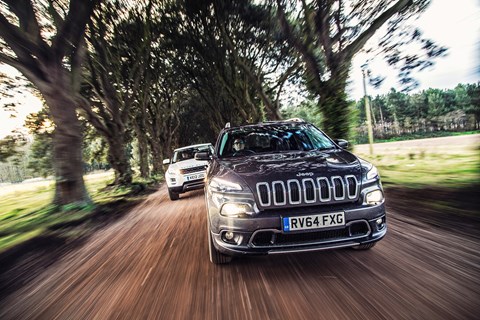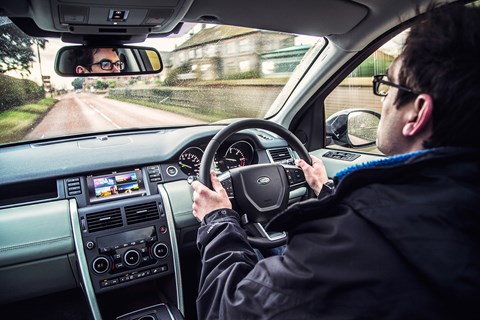► It’s the Discovery Sport’s biggest test
► Four-way group test for class honours
► Disco Sport vs Q5 vs Cherokee vs Evoque
It’s so dark in Norfolk at half past six on a January morning that I very nearly plough straight into the River Burn trying to park. On the one hand I’m in the new Discovery Sport, so there’s a good chance it wouldn’t have noticed, Land Rover’s off-road tech being what it is. On the other, this isn’t exactly the kind of test we had in mind for the new Land Rover’s first foray into the ultra-competitive mid-size SUV mêlée – Mark Walton has already driven it up an Icelandic glacier for CAR, after all.
Instead we’ve got something tougher in mind: a four-way, on-road dogfight against some of the sector’s best and most interesting rivals, played out against a backdrop that’s part countryside, part seaside, all British. Is the Discovery Sport really a credit to the utilitarian panache of the Discovery name? Or is this latest Son of Freelander going to find itself feeling exposed in the face of such scrutiny, like some poor soul who’s lost grip of their towel while changing their trunks on a crowded beach.
Meet the rivals
A distinctive headlight pattern marks Ben Miller’s arrival in the Jeep Cherokee. Sad to say, the pitch black suits our American contender. It is not a pretty car. Slabby, awkward, strangely proportioned, with tiny-looking wheels, squared-off arches and that strangely chamfered grille, distinctive is the best you can say about it. Hard to imagine buying one of these out of desire. It earns its place here as competition to the Land Rover’s authentic off-roader image – Jeep builds off-roaders with luxury pretensions, too. Fancy four-wheel drive and lots of toys included.
Counterpoint to this not-so-rough-but-certainly-ready posturing is the Audi Q5, which rolls-up in the hands of Anthony ffrench-Constant. Our established medium-sized SUV champ is, in reality, more of a crossover – slick and exceptionally well honed, especially on the inside. We also know that it is very good to drive; we picked the SQ5 over the Porsche Macan and BMW X4 back in September 2014. As dawn breaks, however, we each note just how amorphous and dated it looks in this company. Remember when Audi used to be stylish? As Anthony suggests, a makeover in the sharper-edged manner of the latest TT might do the trick.
If it is style you’re after, our final challenger is surely top of the list. Yep, we’ve rounded up a five-door Range Rover Evoque to keep its newest sibling honest. It’s a pre-loved 12-plate example that wears its mileage very lightly, here to represent the kind of car early-ish adopters might now be looking at trading for the new kid on the block, the Discovery Sport. Would that be a worthy upgrade? After all, beneath the skin the two have much in common – both are built on an evolution of the platform that underpinned the Freelander 2.

How does the Discovery Sport justify its place here, aside from simply being new? As the first time the Discovery name has been applied beyond the big, comfy, mud-plugging bus we’re all familiar with, it represents the first fumblings of a second Land Rover dynasty, companion to the current Range Rover trifecta. From the outside Gerry McGovern’s latest work divides opinion: design degree-equipped Ben admires its handsome lines and elegant restraint, while Anthony thinks it’s two cars in one, or, more colourfully, like a partially squashed wasp, dragging its rear end. Harsh.
I like the carried-over Freelander cues and the pebble-smooth shapes. For me they call to mind posh Smeg fridges, where previous Discoverys were boxy Beko.
‘Discovery Sport’ has more market appeal than ‘Freelander 3’, no doubt, but further justification for the name change comes from the seating arrangements. Like all previous Discoverys, the Sport will accommodate seven, which is a bona fide unique selling point in the premium mid-size SUV segment. Two of those seven will have to be small, despite the tilt-slide middle bench, and you can forget about travelling with luggage in this configuration. But there’s plenty of room for bags when the rear seats are stowed in the floor, and as a solution for ferrying both yours and the neighbours’ kids to school on occasion, it adds an extra element of versatility the others can’t match. Putting those rear-most seats up and down is a strap-led cinch, though you need to be a gymnast to get in and out of them.
Engineering, specs
Something else this Discovery Sport has a lot of is gears, for this particular range-topping HSE Luxury example is fitted with ZF’s nine-speed automatic. If there’s a significant chink in the Disco’s on-road performance armour, this is it. Although great for economy on the motorway, the damn thing can’t seem to make up its mind the rest of the time. I find myself using the disappointingly plasticky paddles just to keep it under control.
Jeep also offers this gearbox, but since our Cherokee – a UK top-spec Limited but with the less powerful 138bhp 2.0-litre diesel – has the standard six-speed manual, there’s no opportunity to compare mapping expertise. Soggy and vague, the Jeep’s gearlever is topped with the same horrible plastic pool ball of a gearknob that feels cheap in the Alfa Romeo MiTo, immediately undermining any attempt at a premium interior ambience. Not that the rest of it is particularly successful. You can tell they’ve tried, but the weirdly organic shapes are more alien than human and the materials don’t exude the quality and class of the others.

The Cherokee becomes still easier to dismiss on the road. ‘It’s just underwhelming,’ says Ben. ‘It’d be fine for a two-day road trip on freeways back home in the US – slumped in the seat, bucket of soda on the go – but here it’s out of its depth.’ At times the steering feels like it’s sufffering a kind of satellite delay, and although the seats are the most comfortable here, the ride is easily troubled by broken surfaces and the body motion is by far the least controlled. The cramped rear passenger space polishes it off. While there are plenty of safety and convenience features – power tailgate, wireless phone charging – surely the only reason for choosing the Jeep is a wilful determination to be different.
The contrast between the Cherokee and the Evoque is marked. After a traffic-free B-road blast on the way over, Ben’s smitten by the altogether keener Range Rover, though Anthony reckons the steering is lifeless. As an early TD4 variant no longer available new, this Evoque’s 2.2-litre turbodiesel boasts just 148bhp compared to the 187bhp cranked out by the Discovery Sport’s SD4 2.2. But the action of the Evoque’s six-speed manual gearbox remains fantastically mechanical 18,000 miles into its life, and the four-square stance makes it a fun machine to hustle. Punting it along the narrow lanes in the direction of Hunstanton, it really does behave like an overgrown old-school hot hatch.
Cabins, interiors
Not that many hot hatches have an interior as good as this. Finished largely in black, door trims punctuated by the fancy 11-speaker Meridian hifi standard on this Pure Tech trim level, it manages the clever trick of delivering a commanding driving position with a nicely low-slung feel. Some of the metal accents here are time-worn (dented, proving at least that the metal is real), but the rest of it has shrugged-off fleet life with barely a whimper, as tight now as it was the day it left the factory. Impressive. Five doors or no, this is still the least practical car present, though.
Is the Discovery Sport’s cabin an improvement? The family DNA is clear in the structure (and the carried-over dial cluster), but the Disco is more upright and boasts more modern detailing. These include the F-Type-style climate control dials with integrated temperature displays, and a new infotainment system that is faster, better looking and more intuitive to use. Yet the Terrain Response buttons that dictate the four-wheel drive system’s behaviour are smaller, suggesting a reduced emphasis on their importance. Changing priorities are also evidenced by availability of up to six USB ports and four 12-volt sockets. Are you nearly there yet? The kids won’t care; they’ll be too busy on their phones. Shame the seats are so firm, making the Disco hard on the arse during longer journeys.

The big surprise is just how good the Discovery Sport proves from behind the wheel. Could be the age of our Evoque, but the Disco is decidedly more engaging. At once its both more composed and more agile, and capable of propelling its 1863kg along at an almost indecent lick. The Evoque doesn’t feel much slower, courtesy of a 193kg weight advantage, but increased feedback means you can lean on the Discovery’s four-wheel drive system with far greater confidence, even if the ride’s a touch choppy. As Anthony opines, ‘it leaps about a bit, but handles rather well.’ An all-new multi-link rear axle, designed to enable that seven-seater packaging without compromising off-road ability, helps. Certainly, as we find out on a handy track cutting across rolling hills, it shrugs off a bit of casual green-laning. But then so will the others, even the Q5.
Ah, the Q5. I elect to take it overnight and, bathed in the familiar glow of that Audi internal architecture, it makes a traffic-clogged, rush hour slog as bearable as it can be. The infotainment works logically, the build quality is beautiful and the ergonomics are excellent. Since S-line spec no longer means hard-line, it’s also the most comfortable in this contest, controlling its interaction with every kind of road surface with great tact and authority.
If the journey home was a tonic, the journey back is a quadruple espresso. With a clear path, the 175bhp 2.0-litre TDI Quattro absolutely flies – its 43kg leaner mass and the superbly responsive, seven-speed dual-clutch gearbox making short shrift of the Discovery’s additional power, the Q5’s remarkable chassis doing the rest. You quickly learn exactly how to manipulate the kick-down programming to prepare for overtakes, it has the best brakes, the best steering and is most definitely the best of the bunch when you discover you’ve carried just a little too much speed into that tightening corner. I arrive not only much earlier than the others, but with a massive grin and a fearsome desire to hand it victory immediately.
Yet, as Ben – smitten with the Disco – points out, does the Q5 properly count as an SUV in this company? It’s got the Sport part down pat, but is it really a Utility Vehicle, or merely a tall car? It’s spacious, yes, but the sheer familiarity of Audi’s indoctrinal design philosophy sublimates that you could be driving almost anything with four rings on the front. Anthony rejects the relevance of this argument; it doesn’t make the Q5 any less good. Still, the Discovery Sport, and by extension the Evoque, remain firmly rooted in their off-roader origins, even as on-road sophistication increases. It’s a difference that makes them feel special, and the contrast colours the rest of the test.
Verdict
In the end the Jeep is nowhere – it lacks the style, the substance and the desirability to stand its ground. It’s not even that much cheaper than the others, given the manual gearbox and the less powerful engine; the equivalent 168bhp four-wheel drive auto starts at £37,195. The Evoque, for all its visual brilliance and sheer desirability, is also out-gunned. Maybe a newer example would have fared better but the Discovery Sport is the nicer drive. It’s also more practical, similarly luxurious and slightly less pretentious.
At £42,995 before options, the Disco is the most expensive candidate here, yet the majority of its strengths – the seating for seven, the 187bhp engine, the neat handling – apply to the entry-level £32,395 SE as well. And despite Anthony’s eloquent protests, the feeling that you’re driving something that’s both different to a regular car and largely uncompromised is surely going to appeal to buyers. If cornering dynamics are your priority, the choice is clear: buy the Audi. But if you want a more versatile, more Country Life kind of experience, the Discovery Sport is a fantastically well-rounded solution.